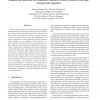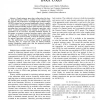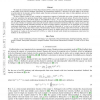104 search results - page 17 / 21 » Capacity of the Trapdoor Channel with Feedback |
TIT
2008
13 years 7 months ago
2008
Abstract--For output-symmetric discrete memoryless channels (DMCs) at even moderately high rates, fixed-block-length communication systems show no improvements in their error expon...
ICNP
2005
IEEE
14 years 1 months ago
2005
IEEE
While extensive efforts have been devoted to providing optimization based, distributed congestion control schemes for efficient bandwidth utilization and fair allocation in both ...
ICC
2007
IEEE
14 years 1 months ago
2007
IEEE
Abstract— Despite primary space-time coding where the channel state information (CSI) is available at the receiver only, the capacity and performance of multiple-input multiple-o...
VTC
2008
IEEE
14 years 1 months ago
2008
IEEE
—Opportunistic beamforming (OB) relies on the transmission of Channel State Information (CSI) in the form of instantaneous Signal to Noise Ratio (SNR) from Mobile Stations (MSs) ...
CORR
2010
Springer
13 years 7 months ago
2010
Springer
We study the communication over Finite State Channels (FSCs), where the encoder and the decoder can control the availability or the quality of the noise-free feedback. Specificall...



